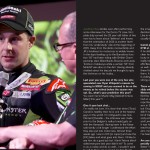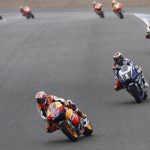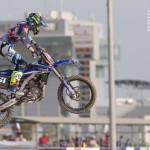There is some weight to the idea. The last two MXGP FIM World Championships have been won by category rookies and at the ages of 23 and 19 steering different types of works machinery. To put both Romain Febvre and Tim Gajser’s achievements put into perspective they have faced opposition from six other factory teams outside of their own and nineteen competitors in the premier class that boast experience of taking a Grand Prix chequered flag or uncorking podium champagne. Stefan Everts won the last of his titles in 2006 at the age of 34. Steve Ramon was next at 28 then David Philippaerts in 2008 with 25 years on the clock. Tony Cairoli’s run of six crowns began in 2009 when the Sicilian was 24. Febvre owned proceedings at 23 in 2015 and now Gajser has chopped the scale down to the sub-20s.
Is MXGP – now with twenty rounds, forty motos and sixty race starts (including Qualification Heats) – becoming even more of a young man’s game? A contest that always involves a slice of fortune is better built on the virtues of youth, namely through the risk-takers and the aggressors? Perhaps it is just natural evolution of a supremely physical sport. One in which Ryan Dungey is a double AMA Supercross Champion at 26 and Ken Roczen a world MX2 and double AMA Motocross No.1 just after his 22nd birthday.
One thing seems to be fairly clear: Febvre and Gajser have injected more urgency into MXGP. The best example was seen at the Grand Prix of France at St Jean D’Angely in June. Both pulled clear of the pack and were barely separated until the final laps, sharing a moto win each with Febvre taking the overall thanks to his second moto chequered flag. It was not just the authority of the result but also the manner of the performances with both running a ragged edge and living little in the locker. The duo were embroiled in a championship dispute until Febvre’s probing and pacey instincts bit back with a crash in qualification for the British Grand Prix that caused a concussion and derailed the season. In the remaining seven rounds Romain made the podium twice but didn’t bag another twenty-five points.
“Two young guys came into the class and pushed the level up and we have to fight more for it,” commented Monster Energy Kawasaki’s Clement Desalle during an interview at Lommel for the Grand Prix of Belgium in July. Desalle, like peers such as Rockstar Energy IceOne Husqvarna’s Max Nagl and HRC’s Gautier Paulin have been the chief challengers to Cairoli (now 30) since the start of the decade. The Belgian is also one of five fathers in the MXGP crop. He managed a twentieth Grand Prix win at Assen in August (with a 3-3) and is the second most successful rider aside from Cairoli in the last ten years in the MXGP division. Desalle has also had a poor run with injury and since 2010 has never been able to reach the final motos of campaign for the main prize. In fact with the exception of ‘10 when Cairoli clinched his second MXGP gong (and first for KTM) with two rounds to go, ‘222’ has managed to have a championship party at least a round early from ’09-’14.
“It is important to find a good limit,” Desalle believes. “Sometimes when I see the videos [of this year’s races] you can really see the limit. As the years pass you get more experience. Let’s see how the future turns out because the young guys are very fast and pushing a lot and I think that will change. It is hard to live on the limit all the time without being injured.”
To gauge what people are seeing, thinking and observing in MXGP we formulated three questions and grabbed a cross-section from the paddock…
Is there a sea change coming into MXGP?
Tony Cairoli, Red Bull KTM, 2nd in the 2016 MXGP FIM World Championship: ‘I don’t think the speed has gone up much but there are more riders at a better level. Before four-five riders were good and the rest were so-so. Now it seems from one to thirteen the speed is closer. If you have a bad race you are ninth or tenth whereas before you were fourth or fifth.’
Marnicq Bervoets, Team Manager, Kemea Yamaha: ‘Last year we saw Romain Febvre more aggressive on the bike and now Tim Gajser. When you saw them riding the 250s then you thought ‘they’re gonna crash on the 450’ but it didn’t turn out to be true and it looks like they can handle the bikes with that style. I think this means that the bikes are handling much better now than in years before. The suspension is better, the chassis is a lot better and engine-wise with the electronics is not so aggressive and you can open the gas immediately without freaking out and that helps.’
Dirk Gruebel, Red Bull KTM Team Manager (MX2): ‘It looks like they have a different approach in the first fifteen minutes of the race. They go 110% and push really hard. If you go three-four years back then people made the start, pushed for two laps, somehow they settled and then they raced. Now it looks like they go as hard as they can and look to survive until the end.’
Stefan Everts, General Manager, Team Suzuki, x10 World Champion: ‘I don’t think it will be like this every year. Tony had been at the top for quite a few seasons and I think we are just seeing the new generation coming in to take over. Febvre, Gajser and next year Herlings are going to be the ones taking championships for the coming years. I don’t think we’ll see a new guy popping up every year to take over.’
Cairoli: ‘I don’t think we are seeing some ‘new generation’. There have been two good years for ‘them’ and a lot of injuries to me, Desalle, Nagl. This year there were some up-and-downs for me. Lets say they are a little wilder in some places and they get lucky with some sketchy moments…but that is part of motocross. They are young and they go for it whereas we maybe think about staying safe and go for points. Maybe their approach is working a little bit better at the moment. For me second place is also quite good. In thirteen years of Grand Prix motocross I have stayed part of the top three and I cannot complain. Next year we’ll be more ready.’
To read the rest of the article go straight to the new OTOR and pick up the story HERE








